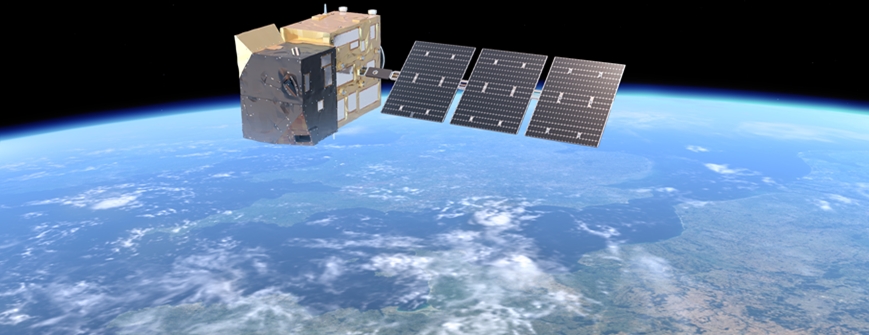Earth observation from space
New satellites deliver precise emission maps
Space offers a new perspective on greenhouse gases and air pollutants: In future, European satellites will for the first time provide detailed emission maps, all the way down to the contributions of individual power plants and industrial facilities. The necessary methods and technologies were developed by Empa researchers within international research partnerships.

As of 2027, new satellites for CO2 measurement (CO2M) will be launched into orbit. Originally, only two were planned – but simulations by Empa convinced the European Commission to have a third satellite built. This will significantly improve coverage on a global scale: Instead of every five days, the greenhouse gases carbon dioxide (CO2) and methane (CH4) can now be measured around the globe every 3.5 days. The new instruments will provide comprehensive greenhouse gas images with a resolution of two kilometers, covering entire regions rather than just narrow measurement strips as previous satellites have done. This will allow the emissions of individual countries, cities, or even individual power plants to be determined in spatial detail. The CO2M mission is part of the EU's Copernicus Earth observation program. It is being developed by the European Space Agency (ESA) and will then be handed over to the European Organization for the Exploitation of Meteorological Satellites (EUMETSAT) for operation. Its goal is to monitor human-caused CO₂ emissions worldwide.
Nitrogen dioxide measurements make the difference
“Satellites measure the concentrations of greenhouse gases and air pollutants in the atmosphere – but only with the help of complex dispersion simulations can we calculate the emissions of a power plant, a city, or even an entire country,” explains Gerrit Kuhlmann from Empa's Air Pollutants / Environmental Technology lab. In order to find out which technologies are suitable for such analyses, Empa researchers simulated the CO₂ measurement data of a future satellite some years ago. These computer simulations, commissioned by ESA, were decisive in ensuring that the CO2M satellites will measure not only CO₂, but also nitrogen dioxide (NO₂). This combination is crucial because it allows man-made emissions to be distinguished from natural sources: The combustion of coal, oil, and gas always produces NO₂ in addition to CO₂, in contrast to natural CO₂ emissions of the biosphere.
Today, Empa researchers are applying their models to real satellite data. Measurements from the European Copernicus satellite Sentinel-5P demonstrate how reliable the method is. Its TROPOMI instrument detects nitrogen oxides emissions from large power plants in the US, for instance. “We were able to clearly identify the exhaust plumes of several power plants and determine their nitrogen oxides emissions,” says Kuhlmann. “Power plants in the US have to report their emissions daily – and our calculations correspond very well with these reports.” This goes to show that satellites are a reliable tool not only for observing emissions, but also for quantifying them with a spatial resolution of just a few square kilometers.
Tracking down major emitters
Empa researchers are not only focusing on regions with good data coverage such as Europe and North America. As part of the European CORSO project, a global dataset is currently being compiled on major emitters such as coal, gas, and oil power plants, cement plants, and iron and steel factories. Comparing nitrogen oxides emission estimates based on public and commercial databases with actual TROPOMI measurements has already yielded some surprises: Some of the listed plants do not even exist, while others were missing from the emissions databases. In many countries, the assumptions about the fuels used were also incorrect – for example, in the case of so-called dual-fuel power plants, which can be operated with both oil and gas. “We were able to show that gas is mainly used in many places, which leads to significantly lower nitrogen oxides emissions than assumed,” explains Kuhlmann.
The methods and technologies developed are also to be applied to greenhouse gases such as CO₂ in the future. “Today, we can already reliably quantify air pollutants such as nitrogen oxides using satellite data. In a few years, we will also be able to accurately and continuously monitor major greenhouse gas sources worldwide with the CO2M satellites,” says Kuhlmann. This opens up a new perspective from space that shows in detail whether the world is really making progress in climate mitigation.
PD Dr. Gerrit Kuhlmann
Air Pollution / Environmental Technology
Phone +41 58 765 47 53
Space technologies
Empa's research is conquering space. From components for space probes and imaging techniques for satellites to materials development on the International Space Station: Empa researchers are working on a wide range of materials and technologies for use at the “final frontier”. But no matter how high the research flies, it is still down-to-earth, as technologies for space have a variety of applications on Earth, whether for innovative electronics, medical devices, or monitoring environmental agreements.
Read the EmpaQuarterly online or download the PDF version.
-
Share






